JÉ RÉ MIE, Haiti—Nearly a week after Hurricane Matthew slammed
into the southwestern tip of Haiti, the scale of destruction is
starting to become clear as residents begin to rebuild homes and
businesses, and as shortages of food and fresh water threaten to
tip some remote areas into humanitarian crisis.
Haiti's president, Jocelerme Privert, and U.S. Ambassador Peter
F. Mulrean visited this storm-battered coastal city Saturday to
observe the worst devastation the nation has seen since an
earthquake in 2010 killed as many as 220,000 people.
The storm last week swept through Haiti, the poorest country in
the Western Hemisphere, destroying thousands of homes and acres of
croplands, shutting down schools, and delaying a hotly contested
presidential election.
The death toll seems likely to rise. Some news reports have
tallied more than 800 dead, mainly along the southwestern
peninsula, including the cities of Jé ré mie and Les Cayes. More
than 60,000 people have been displaced by the storm and are living
in temporary shelters, said Jude Saint-Natus, an official with
Haiti's Interior Ministry.
The hurricane flattened miles of homes along the coastal road
leading into the center of Jé ré mie, a city of 30,000 known to
Haitians as the "City of Poets" for its literary heritage.
Within the city was a scene of devastation.
Winds tore the roof off the St. Louis King of France cathedral.
On the Rue Stenio Vincent, the main commercial strip, dozens of
businesses and sidewalks had been decimated. Tree branches, downed
power lines, and pieces of storefronts and roofs lay in piles of
mud. The stench of rotting food filled the air.
Simon Paulson, a shop owner who moved to Jé ré mie from Atlanta
seven years ago, said he had lost about 200,000 Haitian gourde
($3,100) worth of inventory after seawater surged into his
stockrooms. Looters had tried to steal food from his shop about 20
times in three days, he said.
He compared the hurricane with the 2010 earthquake. "It feels
like the same thing all over again. It's very discouraging," he
said. "This storm was an inferno. This is our Aleppo."
Carmin Magloire, another shop owner on the street, said that he
had lost half of his inventory, and that two houses he owns were
destroyed. As he spoke, workers sorted through large, sodden bags
of macaroni pasta, trying to salvage dry pieces.
Health officials are worried about an increase in cholera cases
due to the lack of clean drinking water. In the past six years,
around 10,000 Haitians have died from the disease, and there have
been about 27,000 cases already this year.
At the St. Antoine Hospital overlooking Jé ré mie, Carlyne
Bernard, an official with the local health department, said the
hospital had received 38 patients seeking treatment for cholera in
the past three days.
Throughout the city, residents zoomed by on motorcycles carrying
tanks of drinking water and other supplies, a sign that the
population here is beginning to dig out from the damage caused by
the hurricane.
A third Boeing 747 cargo plane landed in Port-au-Prince on
Sunday, bringing the total amount of nonfood aid supplies to 264
metric tons to help some 1.5 million people affected by the storm,
according to the U.S. Agency for International Development. About
750,000 people need assistance, according to the United Nations.
That includes blankets, plastic sheeting, kitchen sets and hygiene
kits.
"Our main concern and our No. 1 focus is getting food and fresh
drinking water out to the areas that are cut off, as soon as
possible," said Tim Callahan, team leader for USAID's Disaster
Assistance Response Team in Haiti. "The issue is how to get
supplies in there, and it's really by boat or by helicopter at this
point."
Alta Jean Baptiste, executive director of the Department of
Civil Protection, said Hurricane Matthew was different from earlier
storms because of the combination of flooding and extremely high
winds, and the degree to which houses and crops were destroyed,
which has left thousands of Haitians at risk of famine.
"In the last 30 years, we've never dealt with such violent
winds," Ms. Baptiste said. "We can only supply food for a while,
and then in a parallel way, we have to restore agriculture so
people are able to grow their crops."
Haiti's Ministry of Agriculture is preparing an effort to
provide farming equipment and seeds to replant light winter crops
such as carrots, potatoes, beets and cabbage, and over the next few
months will do the same for hardier spring crops such as beans,
corn and sweet potatoes. "If they fail in that campaign to grow
spring crops, it will be a disaster," Ms. Baptiste said.
Lynn Black, a disaster-response specialist at Massachusetts
General Hospital in Boston, who sits on the board of the St.
Boniface Haiti Foundation, visited Les Anglais, an isolated town of
approximately 25,000 at the far western end of the peninsula on
Saturday afternoon.
She said the mayor of the town had reported 185 dead, more than
700 injured and at least 25 new cases of cholera, and that the sole
local physician, Saintima Fresnel, was down to four bags of
intravenous fluid at a local clinic. Residents said no government
aid workers had reached the town, and that food supplies were
running low because all four bridges leading into the community had
been destroyed, Dr. Black said.
"Everyone, including newborn babies, is drinking contaminated
water right now," Dr. Black said. "This is truly a humanitarian
crisis. And I don't think Les Anglais is a unique community. Every
town and commune along the coast is in a similar situation."
Back in Jé ré mie, Maarten Boute, chairman of wireless telephone
provider Digicel Haiti, said the company had lost its entire
network after the storm in the Grand'Anse Department, which
includes Jé ré mie, and it took three days to fully restore
service.
"The good news is, the town has picked up again," Mr. Boute
said. "People are picking up their lives, rebuilding their roofs,
commerce is starting up again."
The Haitian government, especially the president's office and
the department of Civil Protection, is taking a larger, more
central role in coordinating large donations of humanitarian aid
supplies from the U.S., Canada, the European Union and others than
it did after the 2010 earthquake, said Yvonne Helle, senior country
director for the United Nations Development Program in Haiti.
"There's a whole structure now at the national level, all the
way down to the communal level" to coordinate efforts, she said.
"It's a huge difference from six years ago. It's light years
better."
Write to Robbie Whelan at robbie.whelan@wsj.com
(END) Dow Jones Newswires
October 09, 2016 22:05 ET (02:05 GMT)
Copyright (c) 2016 Dow Jones & Company, Inc.
Boeing (NYSE:BA)
Historical Stock Chart
From Mar 2024 to Apr 2024

Boeing (NYSE:BA)
Historical Stock Chart
From Apr 2023 to Apr 2024
